Walking is, apparently, the new fitness routine. It’s also the best way to get out and enjoy some fabulous nature sights at this time of year. With so many public access footpaths across the Roseland, it’s now the best time of year to rediscover what your legs were meant for.
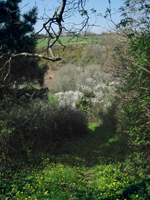 From Churchtown Farm, Gerrans, there is a footpath that runs west across the grass pasture, leading across the valley to Lanhay. The steep path down to the stream at the valley floor is flanked by a curious mix of plantation land to the south and farmland to the north, where the evidence of badger activity is clear from pug marks (depicted), earth digs and large tunnel entrances of an infrequently used outlier sett. Badgers use this path on both sides of the stream, their crepuscular foraging leaving small piles of fresh soil as they seek out earthworms and beetles that form a large part of their diet.
From Churchtown Farm, Gerrans, there is a footpath that runs west across the grass pasture, leading across the valley to Lanhay. The steep path down to the stream at the valley floor is flanked by a curious mix of plantation land to the south and farmland to the north, where the evidence of badger activity is clear from pug marks (depicted), earth digs and large tunnel entrances of an infrequently used outlier sett. Badgers use this path on both sides of the stream, their crepuscular foraging leaving small piles of fresh soil as they seek out earthworms and beetles that form a large part of their diet.
 Arriving at the valley floor, where it is quite wooded and the stream noisily trickles under the slate slab bridge, you may hear the rasping call of Jays that inhabit this territory, along with calling Chiffchaffs recently arrived from Africa, and the beautiful lilting song of Blackcaps. You may see all or any of these animals if you tread noiselessly, but you are most likely to hear them or see evidence of them first.
Arriving at the valley floor, where it is quite wooded and the stream noisily trickles under the slate slab bridge, you may hear the rasping call of Jays that inhabit this territory, along with calling Chiffchaffs recently arrived from Africa, and the beautiful lilting song of Blackcaps. You may see all or any of these animals if you tread noiselessly, but you are most likely to hear them or see evidence of them first.
 Climbing the steep valley on the other side, more evidence of badgers foraging is accompanied by the occasional sighting of Roe deer slots. Again, these animals are most likely to be seen at dawn and dusk if you are lucky.
Climbing the steep valley on the other side, more evidence of badgers foraging is accompanied by the occasional sighting of Roe deer slots. Again, these animals are most likely to be seen at dawn and dusk if you are lucky.
This side of the valley is clothed in low scrub, and in occasional bare patches you may see common lizards basking in the sun, while a plethora of flying insects float above the diverse plant life. This area is abundant in crickets and grasshoppers in the summer months, an important food resource for birds feeding nestlings.
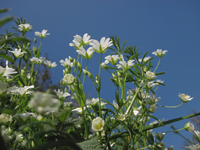 Emerging into the field at Lanhay, across the narrow style deep in the hedge, the landscape changes to grazing land. Lanhay was once a release area for our reintroduced Cirl buntings, and the hedgerows and lane to Polingey creek comprise prime habitat for Cirls and other precious farmland birds. The high diversity of plant life ensures a complex local ecology for all organisms depending upon it.
Emerging into the field at Lanhay, across the narrow style deep in the hedge, the landscape changes to grazing land. Lanhay was once a release area for our reintroduced Cirl buntings, and the hedgerows and lane to Polingey creek comprise prime habitat for Cirls and other precious farmland birds. The high diversity of plant life ensures a complex local ecology for all organisms depending upon it.
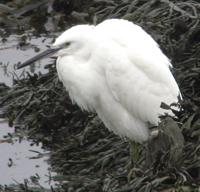 To the human eye it also presents a beautiful mass of colours and forms in spring. Clouds of Stitchwort, Cow parsley and other lush green foliage provide a backdrop for the bright colours of Red campion, Bluebell and Tufted veitch. Above it all, the gorse and blackthorn have been blooming superabundantly this year, further boosting the insect population on which so many of us depend for pollination services. Corridors of hedgerows like this are vitally important for top predators, such as bats and owls that hunt at night.
To the human eye it also presents a beautiful mass of colours and forms in spring. Clouds of Stitchwort, Cow parsley and other lush green foliage provide a backdrop for the bright colours of Red campion, Bluebell and Tufted veitch. Above it all, the gorse and blackthorn have been blooming superabundantly this year, further boosting the insect population on which so many of us depend for pollination services. Corridors of hedgerows like this are vitally important for top predators, such as bats and owls that hunt at night.
At Polingey creek you may cross to the Percuil side, when the tide permits, over the site of the old tide mill, long gone. Look out for little egrets and other water fowl, including Shelduck, foraging on the rich mud of the creek bed.
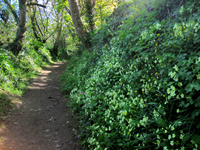 Once across, you may choose to turn right to Percuil, following the creek line, or left and back up towards Gerrans and the long, covered mill lane that leads up to Well Lane and Gerrans church. Along the way you may still see earth banks carpeted in primroses, celandines and the occasional bluebell, while up above you will pass eventually beneath a noisy rookery. This ‘township’ has been established here many years, and some of the nests are old and valuable real estate to their noisy owners.
Once across, you may choose to turn right to Percuil, following the creek line, or left and back up towards Gerrans and the long, covered mill lane that leads up to Well Lane and Gerrans church. Along the way you may still see earth banks carpeted in primroses, celandines and the occasional bluebell, while up above you will pass eventually beneath a noisy rookery. This ‘township’ has been established here many years, and some of the nests are old and valuable real estate to their noisy owners.
The Roseland has many beautiful walks like this one, which should take the walker no more than a couple of hours, depending on ability. The spring into early summer is probably the very best time of the year to drink in the ‘wow factor’ that this Area of Outstanding Natural Beauty has to offer.
Wildlife to look out for this month in the Roseland
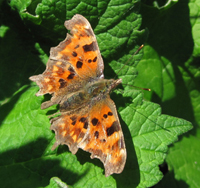 Butterflies: as well as the obvious Small tortoiseshells, Speckled woods, Orange tips and Peacocks, look out for the striking Comma (depicted), Wall, and diminutive Holly blue, all making a comeback this season.
Butterflies: as well as the obvious Small tortoiseshells, Speckled woods, Orange tips and Peacocks, look out for the striking Comma (depicted), Wall, and diminutive Holly blue, all making a comeback this season.
Hirundines: We rejoice at the return of the Swallows and House martins, but have you seen any Swifts yet? These screaming banshees of the air tend to arrive in a bunch, almost overnight around this time of year. So keep an ear out, as you’ll likely hear them before seeing them.
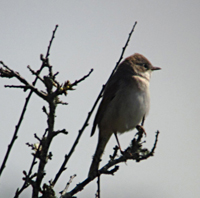 Other avians: Red kites have already been spotted over parts of Cornwall including Falmouth, as they fly to the end of the land mass and back up country again. Check birds of prey high up above you – the kite’s tail is distinctly forked compared to the smaller buzzard’s, which is rather rounded in comparison. Listen out too for the song of the Whitethroat (depicted) along hedgerows; this migrant too has flown here all the way from Africa, south of the Sahara.
Other avians: Red kites have already been spotted over parts of Cornwall including Falmouth, as they fly to the end of the land mass and back up country again. Check birds of prey high up above you – the kite’s tail is distinctly forked compared to the smaller buzzard’s, which is rather rounded in comparison. Listen out too for the song of the Whitethroat (depicted) along hedgerows; this migrant too has flown here all the way from Africa, south of the Sahara.
Marine life: The seas are positively blooming with plankton right now, feeding swarms of jellyfish. They are the harbingers of the coming of the Basking sharks, due around now. Gerrans Bay is a great place to see these enormous, gentle fish. A team from Exeter University have been given the go-ahead to satellite tag Basking sharks, so you may get a glimpse of them out and about in persuit of their quarry. We still know little about the life these animals lead, so the tagging project will be invluable in telling us more.
Things to do this month in the Roseland – Help with a National Trust beach clean
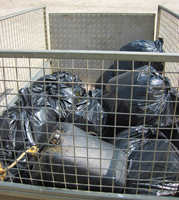 In April, a team of National Trust staff and volunteers combed a number of beaches for rubbish, and what a lot they got! The picture shows the number of filled bags in their large trailer, just from a morning at Pendower, excluding recyclable items such as glass and plastic bottles. Much of the rubbish is plastic or polystyrene that has been floating in the oceans for long periods. Marine litter can be disastrous to wildlife. While old fishing line, net and rope can become entangled round animals, plastic and polystyrene can become ingested, mistakenly taken for food. Cleaning beaches can help prevent the litter washing back out again, as well as making them pleasanter, safer places to visit. The next few beach cleans coming up are for 4 May, 1 June and 6 July 2015, at Porthcurnick and Pendower. Check here for full details.
In April, a team of National Trust staff and volunteers combed a number of beaches for rubbish, and what a lot they got! The picture shows the number of filled bags in their large trailer, just from a morning at Pendower, excluding recyclable items such as glass and plastic bottles. Much of the rubbish is plastic or polystyrene that has been floating in the oceans for long periods. Marine litter can be disastrous to wildlife. While old fishing line, net and rope can become entangled round animals, plastic and polystyrene can become ingested, mistakenly taken for food. Cleaning beaches can help prevent the litter washing back out again, as well as making them pleasanter, safer places to visit. The next few beach cleans coming up are for 4 May, 1 June and 6 July 2015, at Porthcurnick and Pendower. Check here for full details.
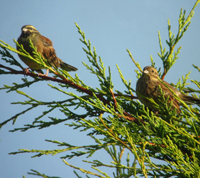 Cirl Bunting Reintroduction Project News
Cirl Bunting Reintroduction Project News
A great start to the season for our Cirls! By the end of April, 33+ pairs were already recorded. This is significantly up on the same time last year. We are hoping to hit a target of 50 pairs by the end of summer. Last year’s total was 39. Watch this space!
All Photography by Sarah E Vandome, unless otherwise indicated.
Enjoy more Roseland wildlife and landscapes – visit my Heart of Roseland Facebook feature:
